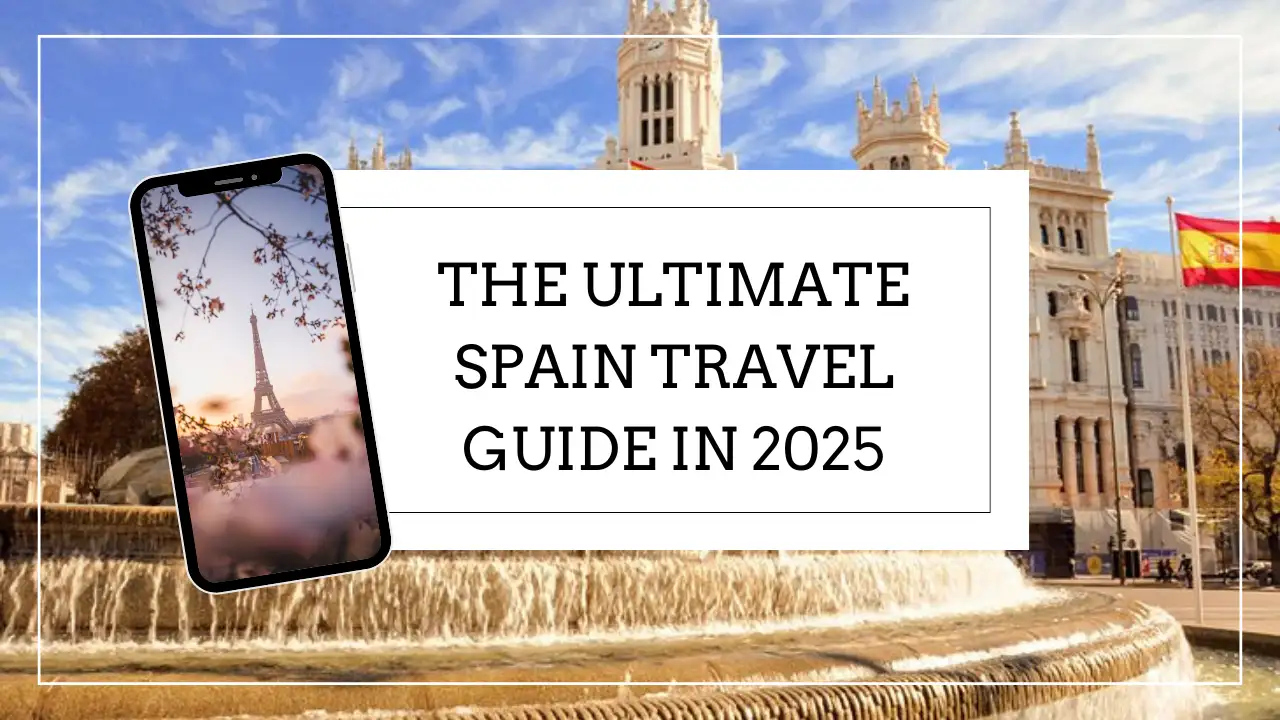Planning your Spanish adventure? This comprehensive Spain travel guide will transform your trip from ordinary to extraordinary. Whether you’re dreaming of flamenco dancers in Seville, architectural marvels in Barcelona, or sun-soaked beaches along the Costa del Sol, Spain offers countless experiences that captivate every type of traveler.
Spain isn’t just a destination—it’s a sensory journey through centuries of rich history, vibrant culture, and breathtaking landscapes. From the snow-capped Pyrenees to the golden beaches of Andalusia, this diverse country promises memories that last a lifetime.

Table of Contents :
Why Spain Should Top Your Travel Bucket List
Spain consistently ranks among the world’s most visited countries, and for good reason. This Mediterranean paradise combines ancient Roman ruins with cutting-edge architecture, traditional tapas bars with Michelin-starred restaurants, and peaceful countryside with bustling cosmopolitan cities.
The Spanish way of life embraces the concept of “vivir la vida”—living life to the fullest. You’ll discover this philosophy everywhere, from the late-night dinner culture to the afternoon siesta tradition. Spain invites you to slow down, savor each moment, and immerse yourself in experiences that feed your soul.
Best Time to Visit Spain: Seasonal Travel Planning
Spain travel guide: Spring Magic (March to May)
Spring transforms Spain into a blooming paradise. Temperature ranges from 60-75°F make exploring comfortable, while tourist crowds remain manageable. This season offers the perfect balance for your Spain travel guide itinerary.
Spring highlights:
- Mild weather ideal for walking tours
- Fewer crowds at major attractions
- Vibrant festivals like Semana Santa (Holy Week)
- Perfect conditions for hiking in national parks
- Lower accommodation prices than summer
Spain travel guide: Summer Adventures (June to August)
Summer brings peak tourist season with long, sunny days and temperatures reaching 85-95°F. Coastal regions become incredibly popular, while inland cities can feel quite hot during midday hours.
Summer considerations:
- Prime beach weather along all coastlines
- Extended daylight hours for sightseeing
- Festival season in full swing
- Higher prices and larger crowds
- Book accommodations well in advance
Spain travel guide: Autumn Discoveries (September to November)
Many travelers consider autumn the ideal time for exploring Spain. Temperatures cool to comfortable levels, summer crowds disperse, and the landscape takes on golden hues that photographers adore.
Autumn advantages:
- Pleasant temperatures (65-80°F)
- Harvest season in wine regions
- Reduced accommodation costs
- Perfect hiking weather
- Cultural events and exhibitions
Spain travel guide: Winter Wonders (December to February)
Winter reveals Spain’s quieter side. While coastal areas may feel cool, this season offers unique experiences like Christmas markets, ski resorts in the Pyrenees, and cozy evenings in traditional tavernas.
Must-Visit Spanish Destinations: Regional Highlights
Spain travel guide: Madrid – The Heart of Spain
Spain’s capital pulses with energy, culture, and history. Madrid seamlessly blends royal palaces with modern art museums, creating an urban experience that satisfies every interest.

Essential Madrid experiences:
- Explore the Golden Triangle of art museums
- Stroll through Retiro Park’s peaceful gardens
- Visit the magnificent Royal Palace
- Experience nightlife in the Malasaña district
- Sample tapas in traditional tabernas
The Prado Museum houses one of the world’s finest art collections, featuring masterpieces by Velázquez, Goya, and El Greco. Meanwhile, the Reina Sofia showcases modern works including Picasso’s famous “Guernica.”
Spain travel guide: Barcelona – Modernist Marvel
Barcelona captivates visitors with its unique blend of Gothic architecture and modernist masterpieces. Antoni Gaudí’s whimsical creations dot the cityscape, while the Mediterranean backdrop adds coastal charm to urban exploration.

Barcelona must-sees:
- Marvel at the Sagrada Familia’s intricate facades
- Wander through Park Güell’s mosaic wonderland
- Explore the Gothic Quarter’s medieval streets
- Shop along Las Ramblas pedestrian boulevard
- Relax on Barceloneta Beach
Gaudí’s architectural genius transforms ordinary buildings into fairy-tale structures. The Casa Batlló and Casa Milà showcase his organic design philosophy, while the still-under-construction Sagrada Familia represents his most ambitious vision.
Spain travel guide: Seville – Flamenco Soul
Seville embodies Andalusian passion through its Moorish architecture, flamenco rhythms, and orange-scented streets. This southern city offers authentic Spanish culture at every turn.

Seville highlights:
- Tour the magnificent Alcázar palace complex
- Climb the Giralda Tower for panoramic views
- Experience authentic flamenco performances
- Wander through the charming Santa Cruz neighborhood
- Visit the impressive Cathedral of Seville
The Alcázar represents one of Europe’s most beautiful royal palaces, featuring intricate Islamic art and stunning gardens. Game of Thrones fans will recognize many filming locations throughout the complex.
Spain travel guide: Valencia – Modern Meets Traditional
Valencia perfectly balances futuristic architecture with traditional Spanish charm. This coastal city invented paella and continues to serve the world’s best versions of this iconic dish.

Valencia attractions:
- Explore the futuristic City of Arts and Sciences
- Taste authentic paella in its birthplace
- Relax on Malvarosa Beach
- Discover the Central Market’s local flavors
- Bike through the Turia Gardens
The City of Arts and Sciences showcases Valencia’s commitment to innovation through its stunning contemporary architecture. These buildings house museums, an aquarium, and an opera house that rivals any in the world.
Spain travel guide: Granada – Moorish Magnificence
Granada preserves Spain’s Islamic heritage through the magnificent Alhambra palace complex. This Andalusian gem offers glimpses into the sophisticated culture of Al-Andalus.

Granada essentials:
- Tour the breathtaking Alhambra palace
- Explore the historic Albaicín neighborhood
- Experience Sacromonte’s cave dwellings
- Visit the Renaissance Cathedral
- Enjoy sunset views from Mirador San Nicolás
The Alhambra represents the pinnacle of Moorish art and architecture in Europe. Book tickets well in advance, as this UNESCO World Heritage site limits daily visitors to preserve its delicate beauty.
Spanish Cuisine: A Culinary Adventure
Spanish cuisine extends far beyond paella and sangria, though both deserve their international reputation. Each region contributes unique flavors, ingredients, and cooking techniques that create one of the world’s most diverse culinary landscapes.
Spain travel guide: Tapas Culture – Small Plates, Big Flavors
Tapas transform dining into a social experience. These small plates encourage sharing, conversation, and exploration of diverse flavors throughout an evening.
Essential tapas varieties:
- Jamón ibérico – Premium cured ham
- Patatas bravas – Spicy fried potatoes
- Gambas al ajillo – Garlic shrimp
- Tortilla española – Spanish potato omelet
- Croquetas – Creamy fried croquettes
- Pimientos de Padrón – Mild peppers with sea salt
- Manchego cheese with quince paste
- Boquerones – Marinated anchovies
Spain travel guide: Regional Specialties – Flavors Across Spain
Each Spanish region develops distinct culinary traditions based on local ingredients, climate, and cultural influences.
Northern Spain:
- Pintxos (Basque small plates)
- Fabada asturiana (hearty bean stew)
- Pulpo a la gallega (Galician octopus)
- Sidra (hard apple cider)
Central Spain:
- Cocido madrileño (chickpea stew)
- Roast suckling pig in Segovia
- Manchego cheese from La Mancha
- Ribera del Duero wines
Southern Spain:
- Gazpacho (cold tomato soup)
- Pescaíto frito (fried fish)
- Salmorejo (thick tomato soup)
- Sherry wines from Jerez
Eastern Spain:
- Paella valenciana (original rice dish)
- Horchata (tiger nut drink)
- Fideuà (noodle paella)
- Turrones (nougat confections)
Spain travel guide: Wine Regions – Liquid Treasures
Spain produces some of the world’s finest wines across diverse regions with unique terroir and grape varieties.
Premier wine regions:
- Rioja: Famous for tempranillo-based reds
- Ribera del Duero: Bold, age-worthy wines
- Rías Baixas: Crisp albariño whites
- Priorat: Intense, mineral-driven reds
- Jerez: Home of sherry production
Transportation: Getting Around Spain
Spain’s excellent transportation infrastructure makes exploring multiple regions convenient and affordable. Choose from high-speed trains, budget airlines, rental cars, or comprehensive bus networks.
Spain travel guide: High-Speed Rail Network
Spain’s AVE (Alta Velocidad Española) trains connect major cities at speeds up to 186 mph. These modern trains offer comfort, punctuality, and scenic routes through diverse landscapes.
Major AVE routes:
- Madrid to Barcelona (2.5 hours)
- Madrid to Seville (2.5 hours)
- Madrid to Valencia (1.5 hours)
- Barcelona to Valencia (2.5 hours)
Book tickets in advance for significant savings, especially during peak travel seasons. The Renfe website offers English-language booking with various fare options.
Spain travel guide: Domestic Flights
Budget airlines like Vueling, Ryanair, and Iberia Express connect Spanish cities quickly and affordably. Flying makes sense for longer distances or when time is limited.
Popular domestic routes:
- Madrid to Barcelona (1.5 hours)
- Madrid to Bilbao (1.5 hours)
- Barcelona to Seville (2 hours)
- Valencia to Santiago de Compostela (1.5 hours)
Spain travel guide: Car Rentals – Freedom to Explore
Renting a car provides maximum flexibility for exploring Spain’s countryside, small villages, and hidden gems. Major international rental companies operate throughout Spain with competitive rates.
Driving considerations:
- International driving permit required
- Toll roads (autopistas) connect major cities
- Speed limits: 120 km/h highways, 90 km/h rural roads
- Parking can be challenging in city centers
- GPS navigation highly recommended
Spain travel guide: Public Transportation
Spanish cities offer excellent public transportation systems including metros, buses, and trams. Purchase multi-day passes for convenience and savings.
City transport options:
- Madrid: Metro, buses, Cercanías trains
- Barcelona: Metro, buses, trams, funiculars
- Valencia: Metro, buses, trams
- Seville: Metro, buses, trams
- Bilbao: Metro, buses, trams
Accommodation Options: Where to Stay
Spain offers accommodation choices for every budget and preference, from luxury paradores to budget hostels, traditional hotels to modern apartments.
Spain travel guide: Luxury Hotels and Paradores
Paradores represent Spain’s unique hotel concept, converting historic buildings like castles, monasteries, and palaces into luxury accommodations. These state-run hotels offer authentic experiences with modern amenities.
Notable paradores:
- Parador de Granada (within Alhambra grounds)
- Parador de Santiago (historic hostel)
- Parador de Cáceres (medieval palace)
- Parador de Ronda (dramatic clifftop location)
Spain travel guide: Boutique Hotels
Boutique hotels throughout Spain combine intimate atmospheres with personalized service. These properties often occupy restored historic buildings with contemporary design elements.
Spain travel guide: Vacation Rentals
Platforms like Airbnb offer apartment and house rentals that provide local living experiences. This option works well for families, longer stays, or travelers seeking kitchen facilities.
Spain travel guide: Budget Accommodations
Spain’s hostel network serves budget-conscious travelers with clean, safe accommodations. Many hostels offer private rooms alongside traditional dormitory options.
Budget-friendly options:
- Youth hostels (albergues juveniles)
- Pension houses (pensiones)
- Budget hotel chains
- Monastery stays (unique cultural experiences)
Cultural Experiences: Immersing in Spanish Life
Spain’s rich cultural heritage encompasses art, music, dance, festivals, and traditions that span centuries. Participating in cultural activities provides deeper travel experiences and lasting memories.
Spain travel guide: Flamenco – The Soul of Andalusia
Flamenco represents more than entertainment—it’s an emotional expression of Spanish culture through song, dance, and guitar. Experience authentic performances in intimate venues rather than tourist shows.
Best flamenco venues:
- Tablao El Arenal (Seville)
- Casa Patas (Madrid)
- Tablao Cordobés (Barcelona)
- Peña Flamenca La Platería (Granada)
Spain travel guide: Spanish Festivals – Celebrating Life
Spanish festivals showcase regional traditions, religious heritage, and community spirit. These celebrations offer unique cultural experiences that vary by season and location.
Major festivals:
- Semana Santa (Holy Week) – Dramatic religious processions
- Feria de Abril (Seville) – Colorful spring celebration
- San Fermín (Pamplona) – Famous running of the bulls
- La Tomatina (Buñol) – Massive tomato fight
- Las Fallas (Valencia) – Spectacular fire festival
- Carnival (Cadiz) – Elaborate costume celebrations
Spain travel guide: Art and Museums
Spain’s artistic legacy spans from prehistoric cave paintings to contemporary masterpieces. Museums throughout the country showcase this incredible cultural wealth.
World-class museums:
- Prado Museum (Madrid) – Classical European art
- Reina Sofia (Madrid) – Modern and contemporary art
- Guggenheim (Bilbao) – Architectural marvel and modern art
- Picasso Museum (Barcelona) – Comprehensive Picasso collection
- Dalí Museum (Figueres) – Surrealist master’s works
Spain travel guide: Architecture – Stones Tell Stories
Spanish architecture reflects the country’s complex history through Roman ruins, Moorish palaces, Gothic cathedrals, and modernist creations.
Architectural highlights:
- Romanesque: Santiago de Compostela Cathedral
- Gothic: Burgos Cathedral, León Cathedral
- Mudéjar: Alcázar of Seville, Teruel towers
- Renaissance: Granada Cathedral, El Escorial
- Baroque: Santiago de Compostela facade
- Modernist: Gaudí’s Barcelona masterpieces
- Contemporary: Guggenheim Bilbao, City of Arts and Sciences
Practical Travel Tips for Spain
Language and Communication
Spanish (Castilian) serves as the official language throughout Spain, but several regions maintain co-official languages like Catalan, Basque, and Galician. Learning basic Spanish phrases enhances your travel experience significantly.
Essential Spanish phrases:
- Hola – Hello
- Gracias – Thank you
- Por favor – Please
- ¿Habla inglés? – Do you speak English?
- No hablo español – I don’t speak Spanish
- ¿Cuánto cuesta? – How much does it cost?
- La cuenta, por favor – The check, please
Currency and Money Matters
Spain uses the Euro (€) as its currency. Credit cards are widely accepted, but carry cash for small purchases, tips, and rural areas where card acceptance may be limited.
Money tips:
- Notify banks of travel plans to avoid card blocks
- Use ATMs for best exchange rates
- Tipping is appreciated but not mandatory (5-10%)
- Small denominations useful for markets and cafes
Spanish Customs and Etiquette
Understanding Spanish customs helps you navigate social situations and shows respect for local culture.
Cultural norms:
- Greet with kisses on both cheeks (friends/family)
- Dress modestly when visiting religious sites
- Dinner typically starts after 9 PM
- Shops close for siesta (2-5 PM) in smaller towns
- Sunday lunch is important family time
Safety and Health
Spain ranks among Europe’s safest countries for travelers. Standard precautions and common sense ensure a trouble-free visit.
Safety guidelines:
- Watch for pickpockets in tourist areas
- Keep copies of important documents
- Use hotel safes for valuables
- Emergency number: 112
- Carry European Health Insurance Card (EU citizens)
Packing Essentials
Pack according to your travel season and planned activities. Spain’s diverse climate requires flexible clothing options.
Packing checklist:
- Comfortable walking shoes
- Light layers for temperature changes
- Modest clothing for religious sites
- Sunscreen and sunglasses
- Universal electrical adapter (Type C/F)
- Portable phone charger
- Spanish phrasebook or translation app
Budget Planning: Making Your Money Count
Spain offers excellent value for travelers across all budget ranges. Strategic planning helps maximize your experience while controlling costs.
Daily Budget Estimates
Budget travelers ($40-60/day):
- Hostel accommodation
- Self-prepared meals and budget restaurants
- Public transportation
- Free attractions and walking tours
- Local bars and cheap entertainment
Mid-range travelers ($80-150/day):
- 3-star hotel or quality pension
- Mix of restaurant meals and picnics
- Combination of trains and buses
- Paid attractions and guided tours
- Moderate dining and entertainment
Luxury travelers ($200+/day):
- 4-5 star hotels or paradores
- Fine dining and wine experiences
- High-speed trains and rental cars
- Private tours and exclusive experiences
- Premium entertainment and shopping
Money-Saving Strategies
Accommodation savings:
- Book directly with hotels for better rates
- Consider vacation rentals for longer stays
- Stay outside city centers for lower prices
- Travel during shoulder seasons
Food and drink savings:
- Take advantage of menú del día lunch specials
- Shop at local markets for fresh ingredients
- Happy hour drinks (usually 7-9 PM)
- Free tapas with drinks in Granada and some other cities
Transportation savings:
- Book train tickets in advance
- Consider bus travel for longer distances
- Walk or bike when possible
- Use city transport passes
Attraction savings:
- Many museums offer free hours
- City tourism cards provide discounts
- Free walking tours (tip-based)
- Explore free parks and neighborhoods
Hidden Gems: Off-the-Beaten-Path Destinations
While major cities attract most visitors, Spain’s hidden gems offer authentic experiences away from crowds.
Coastal Treasures
Costa Brava small towns:
- Cadaqués – Dalí’s coastal retreat
- Tossa de Mar – Medieval charm by the sea
- Calella de Palafrugell – Traditional fishing village
Northern coast discoveries:
- Cudillero (Asturias) – Colorful houses cascade down cliffs
- Hondarribia (Basque Country) – Fortified medieval town
- Luarca (Asturias) – “White Village of the Green Coast”
Mountain Villages
Pyrenees gems:
- Ordino (Andorra border) – Traditional mountain architecture
- Ainsa (Huesca) – Medieval hilltop town
- Taüll (Lleida) – Romanesque churches and mountain views
Interior surprises:
- Albarracín (Teruel) – Pink-hued medieval streets
- Cuenca – Hanging houses over gorges
- Ronda (Málaga) – Dramatic bridge and bullring
Islands Beyond the Mainstream
Balearic alternatives:
- Formentera – Pristine beaches and crystal waters
- Menorca – UNESCO Biosphere Reserve
- Northern Mallorca – Authentic villages and coves
Canary Island discoveries:
- La Palma – “Beautiful Island” with volcanic landscapes
- El Hierro – Smallest and most pristine Canary Island
- La Gomera – Ancient forests and hiking trails
Seasonal Activities: Year-Round Adventures
Spain’s diverse geography and climate support activities throughout the year, ensuring memorable experiences regardless of your travel season.
Spring Activities (March-May)
Spring awakens Spain with perfect conditions for outdoor exploration and cultural immersion.
Spring highlights:
- Hiking in Picos de Europa National Park
- Cherry blossom viewing in Jerte Valley
- Easter processions throughout Andalusia
- Wildflower photography in countryside
- Comfortable city walking tours
Summer Activities (June-August)
Summer transforms Spain into a playground for beach lovers, festival-goers, and outdoor enthusiasts.
Summer adventures:
- Beach hopping along Mediterranean coastlines
- Music festivals like FIB (Festival Internacional de Benicàssim)
- Northern Spain exploration for cooler temperatures
- Camino de Santiago pilgrimage walking
- Late-night dining and flamenco experiences
Autumn Activities (September-November)
Autumn provides ideal conditions for cultural exploration, wine tasting, and comfortable outdoor activities.
Autumn experiences:
- Wine harvest participation in Rioja
- Mushroom hunting in northern forests
- Photography tours of changing landscapes
- Cultural festival seasons
- Comfortable hiking in all regions
Winter Activities (December-February)
Winter reveals Spain’s quieter side while offering unique seasonal experiences.
Winter possibilities:
- Skiing in Pyrenees and Sierra Nevada
- Christmas market exploration
- Thermal spa visits
- Cozy museum and gallery tours
- Traditional winter festivals
Conclusion: Your Spanish Adventure Awaits
This comprehensive Spain travel guide provides the foundation for an unforgettable journey through one of Europe’s most captivating countries. From the artistic treasures of Madrid’s Golden Triangle to the sun-soaked beaches of the Costa del Sol, from the architectural wonders of Barcelona to the flamenco passion of Seville, Spain offers experiences that transform ordinary trips into extraordinary adventures.
Spain’s true magic lies not just in its world-famous attractions, but in the warmth of its people, the richness of its culture, and the joy of living that permeates every corner of the country. Whether you’re savoring tapas in a traditional taverna, watching the sunset from a medieval castle, or dancing until dawn in a vibrant city square, Spain invites you to embrace life with Spanish passion.
Remember that the best Spain travel guide is the one that encourages you to wander, explore, and remain open to unexpected discoveries. While planning provides structure, leave room for spontaneity—some of your most treasured Spanish memories will come from unplanned moments and serendipitous encounters.
Pack your sense of adventure, bring your appetite for new experiences, and prepare to fall in love with a country that has been captivating travelers for centuries. Your Spanish adventure awaits, and the memories you create will last a lifetime.
¡Buen viaje! (Have a good trip!)
Frequently Asked Questions
What is the best time of year to visit Spain?
The best time to visit Spain depends on your preferences and planned activities. Spring (March-May) and autumn (September-November) offer the most comfortable weather with mild temperatures, fewer crowds, and reasonable prices. Summer (June-August) provides perfect beach weather but brings higher temperatures, larger crowds, and premium prices. Winter (December-February) offers unique experiences like Christmas markets and skiing, though some coastal areas may feel cool for beach activities.
How many days do you need to see Spain properly?
A comprehensive Spain travel experience requires at least 10-14 days to visit major destinations like Madrid, Barcelona, Seville, and Granada while allowing time for cultural immersion. However, you can enjoy a meaningful introduction to Spain in 7-10 days by focusing on 2-3 key regions. For deeper exploration including smaller towns, coastal areas, and regional cultures, plan for 3-4 weeks. Remember that Spain’s excellent transportation network allows efficient movement between destinations.
What should I pack for a trip to Spain?
Pack comfortable walking shoes as Spanish cities involve significant walking on cobblestone streets. Bring layered clothing for temperature variations, modest attire for religious sites, sunscreen and sunglasses for strong Mediterranean sun, and a universal electrical adapter (Type C/F). Include a Spanish phrasebook or translation app, portable phone charger, and any necessary medications. Pack according to your travel season—summer requires lighter clothes, while winter may need warmer layers, especially for northern regions.
How much money should I budget for a Spain trip?
Budget travelers can explore Spain for $40-60 per day including hostel accommodation, budget meals, public transportation, and free attractions. Mid-range travelers should budget $80-150 daily for 3-star hotels, restaurant meals, train travel, and paid attractions. Luxury travelers planning fine dining, premium accommodations, and private experiences should budget $200+ per day. Costs vary significantly between regions—Madrid and Barcelona are more expensive than smaller cities and rural areas.
What are the must-try foods in Spain?
Essential Spanish foods include paella (especially in Valencia where it originated), jamón ibérico (premium cured ham), tortilla española (potato omelet), gazpacho (cold tomato soup), and various tapas like patatas bravas, gambas al ajillo, and croquetas. Regional specialties add variety—try pintxos in the Basque Country, pulpo a la gallega in Galicia, and pescaíto frito in Andalusia. Don’t miss Spanish wines from Rioja, Ribera del Duero, and Rías Baixas regions, plus traditional desserts like churros con chocolate and turrones.
Why is Spain such a popular tourist destination?
Spain attracts millions of visitors annually due to its incredible diversity of experiences within one country. The combination of rich history spanning Roman, Moorish, and Christian influences, world-class art museums, distinctive regional cultures, excellent cuisine, beautiful beaches, and warm, welcoming people creates an irresistible appeal. Spain’s excellent infrastructure, safety record, and value for money make it accessible to travelers of all types and budgets. The Spanish lifestyle philosophy of enjoying life, combined with year-round pleasant climate in many regions, ensures memorable experiences for every visitor.





